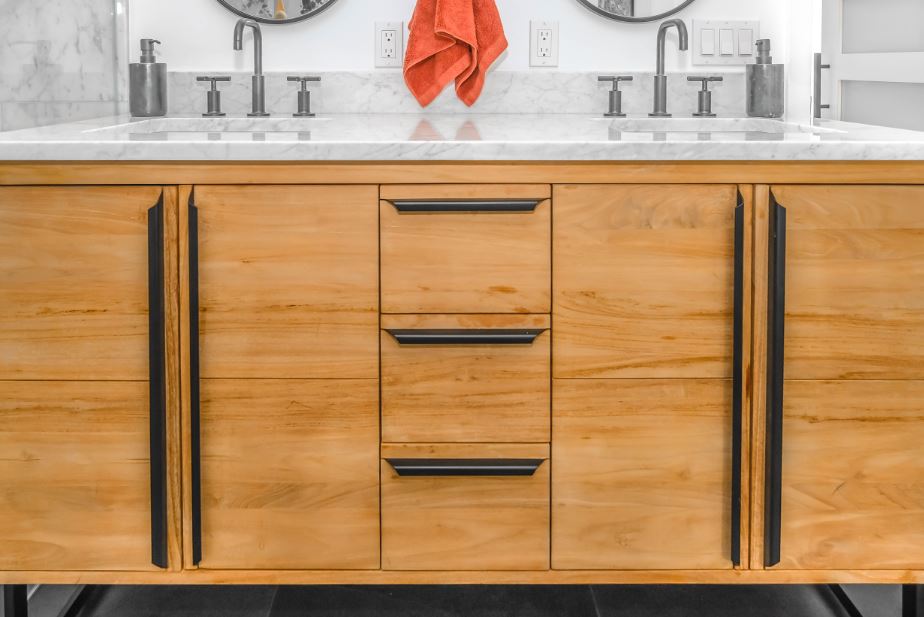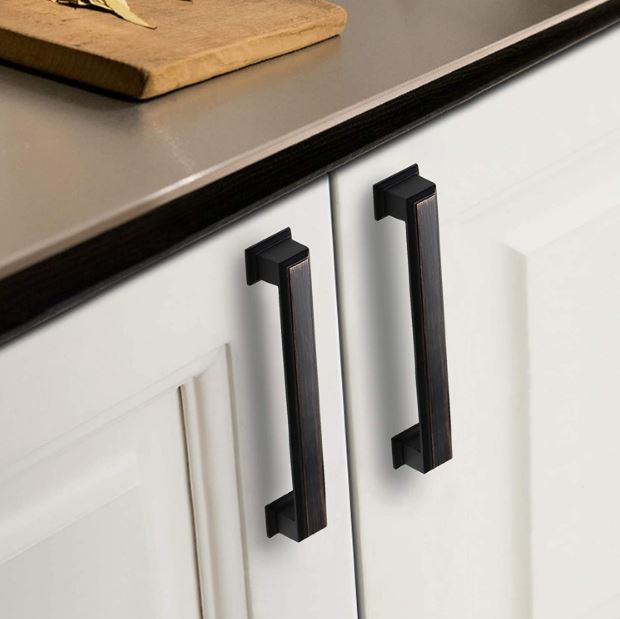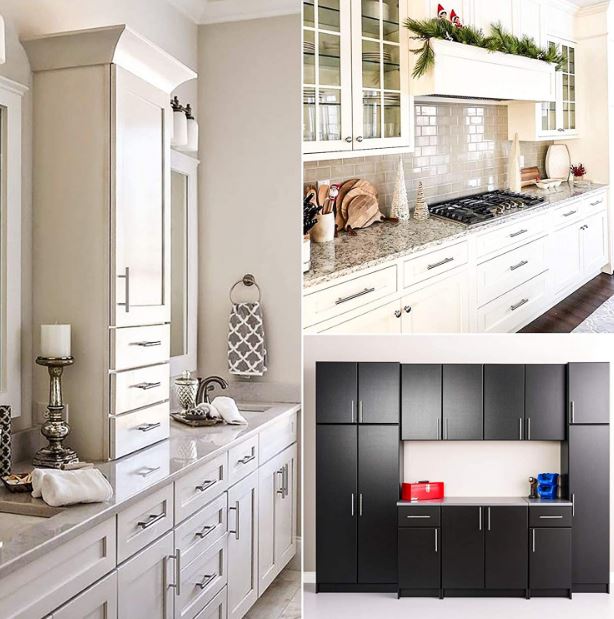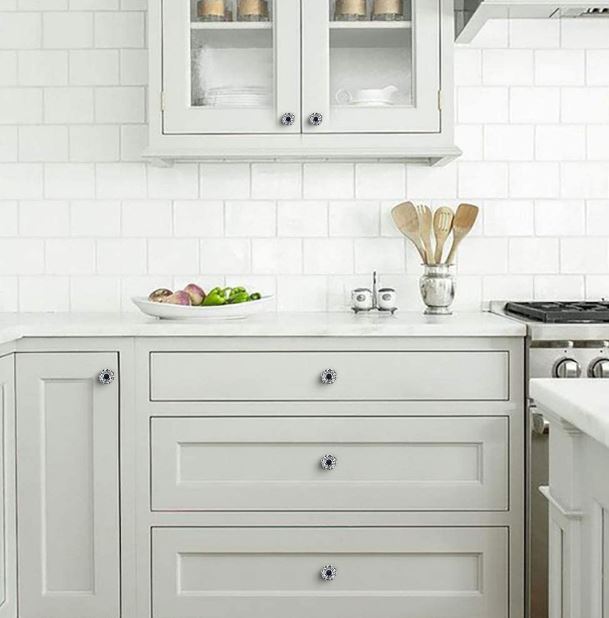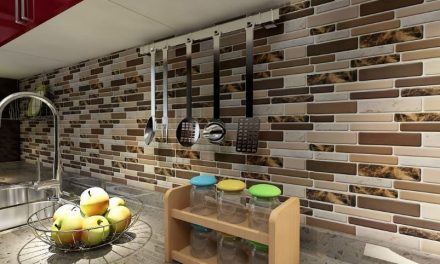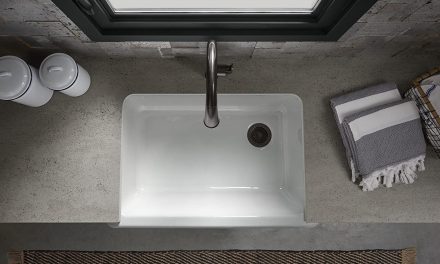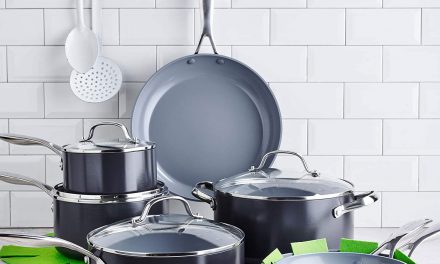The world of cabinet hardware can be surprisingly complicated. Between functional hardware, like drawer slides and hinges, and decorative hardware, like knobs and pulls, there’s a lot to choose from. But we’re here to help.
In this article, we’re talking about materials and finishes. We’ll look at the different options for decorative hardware materials and their advantages and disadvantages.
Types of cabinet hardware materials and finishes
Cabinet hardware is made from a variety of materials and is available in many different finishes. While stoneware and acrylic hardware can be found, by far the most popular materials for cabinet hardware are metal, wood, glass, and crystal.
Metal cabinet hardware
Metal hardware is a great option for kitchens and bathrooms. Metal knobs and pulls are available in a wide variety of styles and finishes to match any design. While generally fairly durable, some cheaper metal hardware is still susceptible to damage. It can be harder to grip than wood or cut crystal, and shinier finishes show even the smallest scratches. The biggest difference between types of metal hardware is the specific metal or alloy the hardware is made from.
Aluminum and zinc alloys are the most affordable metals, and can be finished to look like pricier materials. These materials aren’t as strong as other metals, though, and may dent fairly easily depending on design. Zinc alloy tends to lose its finish after a few years, leaving a patchy appearance that can be hard to repair.
Real copper, brass, and bronze cabinet hardware have antimicrobial properties that cut down on the microbial load of a kitchen or bathroom, but these materials can be finicky and tend to be fairly pricey. Living finishes are especially popular with these materials, meaning the metal is left unlacquered. This allows a natural patina to develop over time, which can really give a warm, lived-in look to a space. However, unlacquered copper, brass, and bronze are highly susceptible to stains from acids and even normal wear. While bronze is relatively hard to damage, copper and brass scratch fairly easily.
Stainless steel is a great option for cabinet hardware, being durable and, as the name suggests, resistant to staining. It is moderately priced and available in many different styles. The only real downside of stainless steel is the lack of finishing options available. Knobs and pulls made from stainless steel may not fit well in more traditionally styled kitchens and bathrooms.
Cast iron and pewter are less common materials for cabinet hardware (and tend to be expensive), but they have distinctive looks that can be a real statement piece. Especially great for vintage styles, these materials are heavy and give a very solid feel to knobs and pulls. Cast iron is strong and durable but usually must be lacquered to prevent rust; its natural finish is even more finicky than copper. Pewter is often intricately detailed, but it’s soft and may scratch and gouge. Make sure you check with the manufacturer before you purchase any pewter hardware, since some pewter contains lead.
Pros
- More durable than glass/crystal, especially when it comes to stainless steel
- Available in the widest variety of styles and finishes
- Real copper, brass, and bronze have antimicrobial properties
Cons
- Can be hard to find some real metals as opposed to metal-like finishes
- Generally smooth surface may make it harder to grip
- Higher shine means small marks are easier to see
- Some materials only work for certain styles
- Not all metal is as durable as stainless steel
Price range: $3-$50 depending on metal, style, finish, and number of knobs/pulls in a package
Wood cabinet hardware
Wood is a good option for cabinet hardware, especially in classic bathrooms and farmhouse kitchens. Wood knobs and pulls are generally very affordable and are often the easiest to grip. But wood hardware can fit into almost any style. Its greatest asset is its versatility. Depending on the type of wood and the finish, it can be pale or dark, light or heavy, and a variety of shades. Go for a natural stain that really highlights the grain or paint your knobs or pulls any color you like. Match cabinets perfectly, or contrast styles to make them really pop.
As a relatively soft material, wood hardware isn’t especially resistant to staining and scratching. Whether painted or stained, its finish can wear off over time and, depending on design, may need to be reapplied regularly. Wood is also susceptible to water damage, so it may need to be sealed. Taken care of properly, though, wood cabinet hardware is a solid, affordable choice.
Pros
- Often more textured and easier to grip
- Available in almost any color
- Easy to match with cabinets
- Generally very affordable
Cons
- Finishes can wear off
- Not especially resistant to staining or scratching
- Susceptible to water damage
Price range: $2-$10 per pull/knob, though antique, reclaimed, or especially uncommon woods or styles can be much more expensive
Glass cabinet hardware
Granting a room anything from a traditional, elegant style to a modern, streamlined look, glass cabinet hardware is very versatile. Glass hardware can bring a lot of light to a space and is available in a variety of colors and styles, including frosted and translucent.

See Shabby Restore’s round, clear glass cabinet knob, which comes with bronze hardware
Glass is great for highlighting the other materials of the hardware or the cabinet itself, though glass pulls may be a little fragile, depending on design.
Know that this is not a particularly durable material, so you should consider how much wear this hardware is likely to experience, especially if you have children or pets. It’s susceptible to scratching and chipping. That said, glass is totally nonporous, so you don’t have to worry about finishes wearing off easily, and it’s generally easy to clean.
Glass isn’t the cheapest cabinet hardware material, but it’s more affordable than crystal while having a very similar look.
Pros
- Brings light to a space
- Available in a variety of colors and finishes
- More affordable than crystal
- Generally easy to clean
Cons
- Can scratch fairly easily
- Glass pulls may be fragile
- Edges may be sharp
Price range: $6-$15 per knob/pull, though more complicated styles can be pricier
Crystal cabinet hardware
Crystal may, at first blush, look a lot like glass. In fact, it is glass and isn’t actually crystal at all. The difference between glass and crystal in knobs and pulls (and glassware) is that crystal has lead oxide added to improve appearance and make it easier to cut. Crystal is heavier than normal glass and has a better shine and sparkle, though it tends to be cut less sharply. Only glass that contains at least 24% lead oxide may legally be called crystal.
The lead in crystal can be a problem for glassware as foods and liquids stay in contact with it for a long time. Cabinet knobs and pulls don’t have this problem and are generally considered relatively safe. However, if you have small children or are especially concerned about lead exposure, crystal glass hardware is a good alternative. Crystal glass is made the same way as crystal, and still has much of its sparkle, but the lead is replaced by barium, zinc, or potassium.
Crystal knobs can make a great statement piece, especially if your kitchen has a lot of natural light. Real crystal and crystal glass can act as prisms, refracting sunlight into a rainbow of colors that provides that “wow” factor. Crystal pulls are less common and may be fragile, but, as crystal is heavier than glass, these pulls will feel very solid. Crystal provides a glamorous, vintage feel to a room, but it is a very distinctive material. No matter the style of knob or pull you choose, it’ll always look like crystal.
Pros
- Feels solid in the hand
- Brings a lot of light to a space
Cons
- May be a small risk of lead exposure from real crystal
- Crystal pulls may be fragile
- Not available in many styles
Price range: $10-$50 per knob; antique styles will be on the high end
Choosing cabinet hardware
Overwhelmed by the world of cabinet hardware? Start with the following:
- Decide which materials will be best for your kitchen or bathroom
- Think about finishes and look
- Consider other hardware options, like drawer slides and hinges, and how they’ll look with your other cabinet hardware
- Check out the options you have for knobs and pulls

